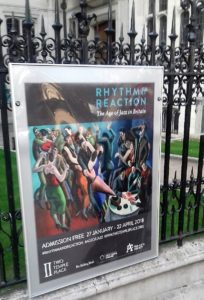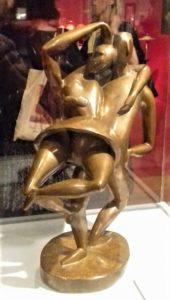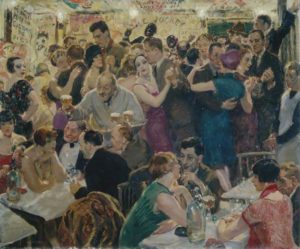This Spring’s exhibition by the Bulldog Trust at Two Temple Place closes after Sunday (tomorrow) so this weekend is the last chance to catch it. It is well worth going along to, especially if you enjoy music with your art.
well worth going along to, especially if you enjoy music with your art.
We went along on Wednesday, to one of the late night, live music evenings. The Temple Place building ( remarkable in its own right, see Undiscovered ) has been given over to displays and sounds, both upstairs and down, which summon the early to middle twentieth century. The exhibition begins in the room on the right of the entrance hall, with reference to ragtime and syncopation, the precursors of jazz and a display of antique instruments. There was film and music of the early period. I loved the pencil and wash drawings of London palais de dance, though it would have been good to know what happened to many of these buildings. The Hippodrome is still there and the Dover Street venues, but, I guess, others are long gone, destroyed by Luftwaffe or property developers. Wyndham Lewis’s Programme for the Cave of the Golden Calf was quite something too.
The bronze sculpture by Frank Dobson was full of energy and dynamism, something of a theme in the art on display here.  Paintings pulsated with movement, one could almost hear the spiky counter melodies of jazz when looking at them. William Roberts The Dance Club (The Jazz Party) 1923 was one such. This is the poster for the exhibition. But there were lots of others, like the modernist Edward Burra and Thomas Dugdale (later better known as a portrait painter). Dugdale’s Night, 1926, was very evocative of a crowded Parisian Jazz Club and reminded this viewer of Monet. There were also postcards, cartoons, textiles and ceramics ( I covet the 1940s coffee set ) jazz-themed London Underground posters and a copy of Melody Maker dated 1935 (I had no idea that the magazine was so old.)
Paintings pulsated with movement, one could almost hear the spiky counter melodies of jazz when looking at them. William Roberts The Dance Club (The Jazz Party) 1923 was one such. This is the poster for the exhibition. But there were lots of others, like the modernist Edward Burra and Thomas Dugdale (later better known as a portrait painter). Dugdale’s Night, 1926, was very evocative of a crowded Parisian Jazz Club and reminded this viewer of Monet. There were also postcards, cartoons, textiles and ceramics ( I covet the 1940s coffee set ) jazz-themed London Underground posters and a copy of Melody Maker dated 1935 (I had no idea that the magazine was so old.)

But upstairs, in the Great Hall, were Smitty’s Big Four, playing Sidney Bechet and Jelly Roll Morton style. Giacomo Smith (alto sax), Pete Horsfall (trumpet), Dave Archer (guitar) and Ferg Ireland (double bass) were joined by an excellent pianist and singer (both uncredited) and they made Two Temple Place swing. The Hall was crowded and very hot, chiller units notwithstanding. This was no fault of the organisers, who would have expected a sudden heat wave after the Spring we have been having so far?
This is an interesting and enjoyable exhibition and I learned a lot from it. I didn’t know, for example, that there was a ban introduced on US Jazz Bands entering Britain in 1935 – it was considered that there were too many of them arriving (they were extremely popular). Nor did I appreciate just how quickly things moved from the promotion of jazz by white bands and promoters at the time of WWI to more authentic proponents in the 1920s (a very good thing). Now I must listen to some of my old jazz recordings again and perhaps re-watch Stephen Poliakoff’s 2013 BBC series Dancing on the Edge.
If you have a spare hour or so this weekend, you could do much, much worse than catching this exhibition in its final days.
For more about art in London during Spring 2018 and before why not read Impressionists in London (at the Tate) Charles I; King & Collector (Royal Academy) The Switch House (standing collection Tate Modern) The Courtauld Gallery (standing collection) Hertford House (Wallis Collection)


 RSS – Posts
RSS – Posts